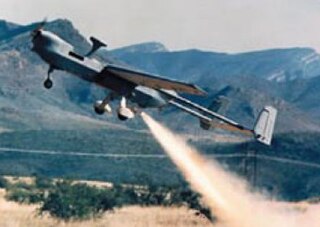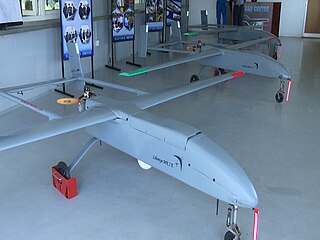Related Research Articles

The IAI RQ-5 Hunter unmanned aerial vehicle (UAV) was originally intended to serve as the United States Army's Short Range UAV system for division and corps commanders. It took off and landed on runways. It used a gimbaled EO/IR sensor to relay its video in real time via a second airborne Hunter over a C-band line-of-sight data link. The RQ-5 is based on the Hunter UAV that was developed by Israel Aerospace Industries.

The AAI RQ-7 Shadow is an American unmanned aerial vehicle (UAV) used by the United States Army, Australian Army, Swedish Army, Turkish Air Force and Italian Army for reconnaissance, surveillance, target acquisition and battle damage assessment. Launched from a trailer-mounted pneumatic catapult, it is recovered with the aid of arresting gear similar to jets on an aircraft carrier. Its gimbal-mounted, digitally stabilized, liquid nitrogen-cooled electro-optical/infrared (EO/IR) camera relays video in real time via a C-band line-of-sight data link to the ground control station (GCS).

An unmanned aerial vehicle (UAV), commonly known as a drone, is an aircraft without any human pilot, crew or passengers on board. UAVs are a component of an unmanned aircraft system (UAS), which include additionally a ground-based controller and a system of communications with the UAV. The flight of UAVs may operate under remote control by a human operator, as remotely-piloted aircraft (RPA), or with various degrees of autonomy, such as autopilot assistance, up to fully autonomous aircraft that have no provision for human intervention.

The Sikorsky Cypher and Cypher II are types of unmanned aerial vehicles developed by Sikorsky Aircraft. They are vertical takeoff and landing aircraft which use two opposing rotors enclosed in a circular shroud for propulsion.

The AAI Aerosonde is a small unmanned aerial vehicle (UAV) designed to collect weather data, including temperature, atmospheric pressure, humidity, and wind measurements over oceans and remote areas. The Aerosonde was developed by Insitu, and is now manufactured by Aerosonde Ltd, which is a strategic business of AAI Corporation. The Aerosonde is powered by a modified Enya R120 model aircraft engine, and carries on board a small computer, meteorological instruments, and a GPS receiver for navigation. It is also used by the United States Armed Forces for intelligence, surveillance and reconnaissance (ISR).

AeroVironment, Inc. is an American defense contractor headquartered in Arlington, Virginia, that is primarily involved in unmanned aerial vehicles (UAVs). Paul B. MacCready Jr., a designer of human-powered aircraft, founded the company in 1971. The company is probably most well known for developing a series of lightweight human-powered and then solar-powered vehicles. AeroVironment is the Pentagon's top supplier of small drones — including the Raven, Wasp and Puma models.

The Boeing Insitu ScanEagle is a small, long-endurance, low-altitude unmanned aerial vehicle (UAV) built by Insitu, a subsidiary of Boeing, and is used for reconnaissance. The ScanEagle was designed by Insitu based on the Insitu SeaScan, a commercial UAV that was intended for fish-spotting. The ScanEagle continues to receive improvements through upgrades and changes.

A miniature UAV, small UAV (SUAV), or drone is an unmanned aerial vehicle small enough to be man-portable.

Luna X 2000 is a German unmanned aerial vehicle (UAV) in service with the Bundeswehr and produced by EMT Penzberg of Germany.

The HAI Ε1-79 Pegasus is a Greek endogenous medium-altitude long-endurance Unmanned Aerial Vehicle produced by the Hellenic Aerospace Industry (HAI/EAB). It entered service with the Hellenic Air Force as Pegasus in 1992, and as the upgraded version Pegasus II in 2005. Its main mission is Intelligence Surveillance & Reconnaissance over-battlefield (ISR-OB).

The Elbit Hermes 450 is an Israeli medium-sized multi-payload unmanned aerial vehicle (UAV) designed for tactical long endurance missions. It has an endurance of over 20 hours, with a primary mission of reconnaissance, surveillance and communications relay. Payload options include electro-optical/infrared sensors, communications and electronic intelligence, synthetic-aperture radar/ground-moving target indication, electronic warfare, and hyperspectral sensors.

Aeronautics Ltd. is an Israeli company specializing in the manufacturing of Unmanned Aerial Systems, commonly known as drones, for military uses. Since its establishment in 1997, the company's products have been sold to over 20 defense, military and homeland security customers in 15 countries. Its headquarters are in Yavne, Israel.

The Northrop Grumman Bat is a medium-altitude unmanned air vehicle originally developed for use by the United States Armed Forces. Designed primarily as an intelligence "ISR" gathering tool, the Bat features 30 lb (14 kg) payload capacity that is unmatched in a 10 ft (3.0 m) wing span.

The AeroVironment Wasp III Small Unmanned Aircraft System is a miniature UAV developed for United States Air Force special operations to provide a small, light-weight vehicle to provide beyond-line-of-sight situation awareness. The aircraft is equipped with two on-board cameras to provide real-time intelligence to its operators. It is also equipped with GPS and an Inertial Navigation System enabling it to operate autonomously from takeoff to recovery. It was designed by AeroVironment Inc., and was first added to the Air Force inventory in 2007. There are two Wasp variants: the traditional version that lands on land, and a version that lands into the sea or fresh water. The Air Force accepted the Wasp AE in late May 2012, and the U.S. Marine Corps revealed in January 2013 that they had ordered the Wasp AE. The Wasp AE is designated as the RQ-12A.

Aeryon Scout is a small reconnaissance unmanned aerial vehicle (UAV) that was designed and built by Aeryon Labs of Waterloo, Ontario, Canada. The vehicle was developed between 2007 and 2009 and produced from 2009-2015. Production has been completed and it is no longer advertised for sale on the company website.

The Saab Skeldar is a medium-range VTOL UAV developed by the Swedish aerospace company Saab. The Skeldar can be used for surveillance, intelligence gathering, light cargo transportation, and electronic warfare.

The AeroVironment RQ-20 Puma is a small, battery powered, American, hand-launched unmanned aircraft system produced by AeroVironment based in California. Primary mission is surveillance and intelligence gathering using an electro-optical and infrared camera.

The use of unmanned aerial vehicles (UAVs) or Drones, is generally regulated by the national aviation authority of the country. Nevertheless, the International Civil Aviation Organization (ICAO) began exploring the use of drone technology as far back as 2005, which resulted in a 2011 report. France was among the first countries to set a national framework based on this report and larger aviation bodies such as the FAA and the EASA quickly followed suit, which eventually led to influential regulations such as Part 107 and Regulation (EU) 2019/947.

The Wind Shadow and Cloud Shadow, also known as Wing Loong-10, is a series of unmanned aerial vehicles of the High-Altitude Long Endurance (HALE) type, featuring an stealthy air-frame. As of 2017 it is being developed by the Chengdu Aircraft Industry Group for reconnaissance and precision strike missions.

Lihiniya MK 1 is an unmanned aerial vehicle under development by the Sri Lanka Air Force (SLAF) and the Centre for Research and Development (CRD) as an experimental platform to test technologies for its indigenous UAV program.
References
- 1 2 3 "Belarus to batch produce UAVs". eng.belta.by. August 9, 2012.
- ↑ The Editor. "Cuba Interested in Belarusian UAS – UAS VISION".